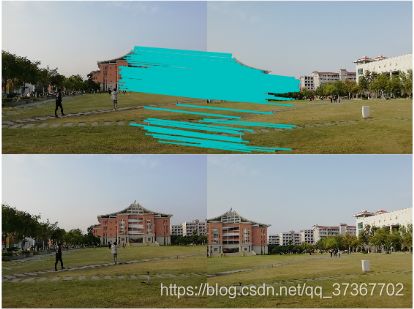【计算机视觉】图像全景拼接 RANSAC
1、全景图像拼接原理
1.1 RANSAC算法原理
RANSAC是“RANdom SAmple Consensus(随机抽样一致)”的缩写。它可以从一组包含“局外点”的观测数据集中,通过迭代方式估计数学模型的参数。它是一种不确定的算法——它有一定的概率得出一个合理的结果;为了提高概率必须提高迭代次数。
RANSAC的基本假设是:
(1)数据由“局内点”组成,例如:数据的分布可以用一些模型参数来解释;
(2)“局外点”是不能适应该模型的数据;
(3)除此之外的数据属于噪声。
局外点产生的原因有:噪声的极值;错误的测量方法;对数据的错误假设。
RANSAC也做了以下假设:给定一组(通常很小的)局内点,存在一个可以估计模型参数的过程;而该模型能够解释或者适用于局内点。
RANSAC的算法步骤:
1. 随机从数据集中随机抽出4个样本数据 (此4个样本之间不能共线),计算出变换矩阵H,记为模型M;
2. 计算数据集中所有数据与模型M的投影误差,若误差小于阈值,加入内点集 I
3. 如果当前内点集 I 元素个数大于最优内点集 I_best , 则更新 I_best = I,同时更新迭代次数k ;
4. 如果迭代次数大于k,则退出 ; 否则迭代次数加1,并重复上述步骤;
注:迭代次数k在不大于最大迭代次数的情况下,是在不断更新而不是固定的
 其中,p为置信度,一般取0.995;w为"内点"的比例 ; m为计算模型所需要的最少样本数=4;
其中,p为置信度,一般取0.995;w为"内点"的比例 ; m为计算模型所需要的最少样本数=4;
1.2 单应性矩阵估计
平面的单应性被定义为一个平面到另外一个平面的投影映射。
这边通过ransac算法来求解单应性矩阵。
1.3 图像拼接
使用RANSAC算法估计出图像间的单应性矩阵,将所有的图像扭曲到一个公共的图像平面上。通常,这里的公共平面为中心图像平面。一种方法是创建一个很大的图像,比如将图像中全部填充0,使其和中心图像平行,然后将所有的图像扭曲到上面。由于我们所有的图像是由照相机水平旋转拍摄的,因此我们可以使用一个较简单的步骤:将中心图像左边或者右边的区域填充为0,以便为扭曲的图像腾出空间。
2、图像拼接代码实现
使用RANSAC算法求解单应性矩阵 RansacModel类是用于测试单应性矩阵的类 里面包含了fit()和get_error()方法
fit()方法计算选取的四个对应的单应性矩阵
get_error() 是对所有的对应计算单应性矩阵,然后对每个变换后的点,返回相应的误差
class RansacModel(object):
""" Class for testing homography fit with ransac.py from
http://www.scipy.org/Cookbook/RANSAC"""
def __init__(self, debug=False):
self.debug = debug
def fit(self, data):
""" Fit homography to four selected correspondences. """
# transpose to fit H_from_points()
data = data.T
# from points
fp = data[:3, :4]
# target points
tp = data[3:, :4]
# fit homography and return
return H_from_points(fp, tp)
def get_error(self, data, H):
""" Apply homography to all correspondences,
return error for each transformed point. """
data = data.T
# from points
fp = data[:3]
# target points
tp = data[3:]
# transform fp
fp_transformed = dot(H, fp)
# normalize hom. coordinates
for i in range(3):
fp_transformed[i]/=fp_transformed[2]
# return error per point
return sqrt(sum((tp - fp_transformed) ** 2, axis=0))
H_from_ransac() 使用RANSAC稳健性估计点对应间的单应性矩阵H。该函数允许提供阈值和最小期望的点对数目。最重要的参数是最大迭代次数:程序退出太早可能得到一个坏解;迭代次数太多会占有太多时间。函数的返回结果为单应性矩阵和对应该单应性矩阵的正确点对。
def H_from_ransac(fp, tp, model, maxiter=1000, match_theshold=10):
""" Robust estimation of homography H from point
correspondences using RANSAC (ransac.py from
http://www.scipy.org/Cookbook/RANSAC).
input: fp,tp (3*n arrays) points in hom. coordinates. """
import ransac
# group corresponding points
data = vstack((fp, tp))
# compute H and return
H, ransac_data = ransac.ransac(data.T, model, 4, maxiter, match_theshold, 10, return_all=True)
return H, ransac_data['inliers']
拼接图像 panorama()使用单应性矩阵H(使用RANSAC健壮性估计得出),协调两幅图像,创建水平全景图像。结果为一幅和toim具有相同高度的图像。padding指定填充像素的数目,delta指定额外的平移量。对于通用的geometric_transform()函数,我们需指定能够描述像素到像素间映射的函数。此例子中,transf()函数就是该指定的函数。该函数通过将像素和H相乘,然后对齐次坐标进行归一化来实现像素间的映射。通过查看H中的平移量我们可以决定应该将图像填补到左边还是右边。当该图像填补到左边时,由于目标图像中的点坐标也变化了,
def panorama(H, fromim, toim, padding=2400, delta=2400):
""" Create horizontal panorama by blending two images
using a homography H (preferably estimated using RANSAC).
The result is an image with the same height as toim. 'padding'
specifies number of fill pixels and 'delta' additional translation. """
# check if images are grayscale or color
is_color = len(fromim.shape) == 3
# homography transformation for geometric_transform()
def transf(p):
p2 = dot(H, [p[0], p[1], 1])
return (p2[0] / p2[2], p2[1] / p2[2])
if H[1, 2] < 0: # fromim is to the right
print('warp - right')
# transform fromim
if is_color:
# pad the destination image with zeros to the right
toim_t = hstack((toim, zeros((toim.shape[0], padding, 3))))
fromim_t = zeros((toim.shape[0], toim.shape[1] + padding, toim.shape[2]))
for col in range(3):
fromim_t[:, :, col] = ndimage.geometric_transform(fromim[:, :, col],
transf, (toim.shape[0], toim.shape[1] + padding))
else:
# pad the destination image with zeros to the right
toim_t = hstack((toim, zeros((toim.shape[0], padding))))
fromim_t = ndimage.geometric_transform(fromim, transf,
(toim.shape[0], toim.shape[1] + padding))
else:
print('warp - left')
# add translation to compensate for padding to the left
H_delta = array([[1, 0, 0], [0, 1, -delta], [0, 0, 1]])
H = dot(H, H_delta)
# transform fromim
if is_color:
# pad the destination image with zeros to the left
toim_t = hstack((zeros((toim.shape[0], padding, 3)), toim))
fromim_t = zeros((toim.shape[0], toim.shape[1] + padding, toim.shape[2]))
for col in range(3):
fromim_t[:, :, col] = ndimage.geometric_transform(fromim[:, :, col],
transf, (toim.shape[0], toim.shape[1] + padding))
else:
# pad the destination image with zeros to the left
toim_t = hstack((zeros((toim.shape[0], padding)), toim))
fromim_t = ndimage.geometric_transform(fromim,
transf, (toim.shape[0], toim.shape[1] + padding))
# blend and return (put fromim above toim)
if is_color:
# all non black pixels
alpha = ((fromim_t[:, :, 0] * fromim_t[:, :, 1] * fromim_t[:, :, 2]) > 0)
for col in range(3):
toim_t[:, :, col] = fromim_t[:, :, col] * alpha + toim_t[:, :, col] * (1 - alpha)
else:
alpha = (fromim_t > 0)
toim_t = fromim_t * alpha + toim_t * (1 - alpha)
return toim_t
主文件
先使用SIFT特征自动找到匹配对应。
from pylab import *
from PIL import Image
import warp
import homography
import sift
# set paths to data folder
featname = ['image/' + str(i + 1) + '.sift' for i in range(3)]
imname = ['image/' + str(i + 1) + '.jpg' for i in range(3)]
# extract features and match
l = {}
d = {}
for i in range(3):
sift.process_image(imname[i], featname[i])
l[i], d[i] = sift.read_features_from_file(featname[i])
matches = {}
for i in range(2):
matches[i] = sift.match(d[i + 1], d[i])
# visualize the matches (Figure 3-11 in the book)
for i in range(2):
im1 = array(Image.open(imname[i]))
im2 = array(Image.open(imname[i + 1]))
figure()
sift.plot_matches(im2, im1, l[i + 1], l[i], matches[i], show_below=True)
# function to convert the matches to hom. points
def convert_points(j):
ndx = matches[j].nonzero()[0]
fp = homography.make_homog(l[j + 1][ndx, :2].T)
ndx2 = [int(matches[j][i]) for i in ndx]
tp = homography.make_homog(l[j][ndx2, :2].T)
# switch x and y - TODO this should move elsewhere
fp = vstack([fp[1], fp[0], fp[2]])
tp = vstack([tp[1], tp[0], tp[2]])
return fp, tp
# estimate the homographies
model = homography.RansacModel()
fp,tp = convert_points(1)
H_12 = homography.H_from_ransac(fp,tp,model)[0] #im 1 to 2
fp,tp = convert_points(0)
H_01 = homography.H_from_ransac(fp,tp,model)[0] #im 0 to 1
# warp the images
delta = 1000 # for padding and translation
im1 = array(Image.open(imname[1]), "uint8")
im2 = array(Image.open(imname[2]), "uint8")
im_12 = warp.panorama(H_12,im1,im2,delta,delta)
im1 = array(Image.open(imname[0]), "f")
im_02 = warp.panorama(dot(H_12,H_01),im1,im_12,delta,delta)
figure()
imshow(array(im_02, "uint8"))
axis('off')
show()
3、运行结果对比
3.1 室外 (景观落差较小)
原图:
sift特征匹配
左边图与中间图落差较大些导致拼接痕迹比右边的明显。
3.2 室外 (景观落差大)
树木参差不齐,光线较暗,建筑较为相似,角度较高
落差大的图片失真率较高,拼接效果也比落差小的差,扭曲程度较大。
3.3 室内
原图:
sift特征匹配
图像拼接结果,黑板部分拼接效果不好,人多的地方拼接效果也不是好,由于sift特征匹配无法对边缘光滑的目标准确提取特征点而导致的。











